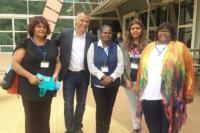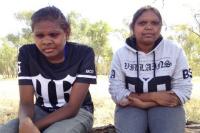In Australia generally 11 out of 100,000 people kill themselves. The frequency is more than double that for indigenous people. Out of 100,000 of their 25 to 29-year-olds 91 take their own lives. Every year at least 5% of all deaths of Aboriginal and Torres Strait Islander peoples are suicides. In some remote Kimberley, Western Australia, communities, the rate has reached 100 times the national suicide average. This ongoing crisis is increasingly significant among 15 to 34-year-olds, where suicide accounts for a third of all loss of life, the biggest cause. The rate of suicide among young Aboriginal men is four times higher than non-Aboriginal young men and five times higher than young Aboriginal women.
This entrenched tragedy brought indigenous academics, researchers and community members from around Australia to a conference on May 5 and 6 in Alice Springs, the heart of the Aboriginal nations, to address what its co-chair, Tom Calma, has called "a suicide epidemic" amongst indigenous people in parts of remote Australia.
An Aboriginal and Torres Strait Islander Suicide Prevention Evaluation Project (ATSISPEP) has been funded by the Australian government to investigate suicide prevention programmes to determine what works, why, and how it can be replicated.
Organised by a national Indigenous Suicide Prevention Project, the Alice Springs conference heard that childhood trauma brought about by lack of access to the most basic human needs of food, safety and care impacts for decades, resulting in already vulnerable people being made more vulnerable to suicide.
“If we are to make real inroads into the scourge that suicide reaps on Australia’s First People it is imperative that language, culture and ceremony be restored,” senior Aboriginal activist, Rosalie Kunoth-Monks, told the hundreds of people at the conference.
“I was reminded of the importance of the connection to country and of the deep and enduring power of family and kinship. Connecting back to culture gives Aboriginal people a big part of their identity, who they are, where they come from, where they belong, where they fit and heals their soul probably," Elder Janine Evans said in a radio interview.
Sandra Evans organised what was dubbed the “Leonora Hope Bus” which brought 12 people, including teenagers, 3,500 kilometres across desert from the tiny Western Australian town of Leonora. They sought answers to the suicide of four young people in the tiny Goldfields town since Christmas.
"Suicide is very serious. It's bigger than deaths in custody. For a long time I've been thinking, why is all this suicides happening? In our language we say 'this is not our culture'. Our young people that we've brought across from Leonora, they're just totally ecstatic because this is a new environment here for them.
"Some of the girls that we brought across ... have suicide tendency and just to see them and sharing with them about how they feel about the trip, they've really opened up."
"We've been told to forget about culture and move forward in mainstream. But as a result there's a lot of suicides," Evans said.
Leading Indigenous health experts, Professors Tom Calma and Pat Dudgeon have urged primary health networks to partner with indigenous communities in suicide prevention, which receives funding under the National Aboriginal and Torres Strait Islander Suicide Prevention Strategy.
In one of several articles in NACCHO Aboriginal Health News previewing Alice Springs, Calma and Dudgeon urged policy makers and services to work with indigenous communities, who must be in the driver’s seat.
They call for comprehensive, proactive and preventative responses, rather than threats to close communities and other such traumatic interventions. “Let’s think about investing in these communities, rather than seeing them as a drain on the public purse,” they say.
They also warn against knee jerk responses of removing children from families in crisis, rather than working with their families. “While removal is necessary in extreme cases, it should always be seen as a last resort. We need to break the intergenerational cycles of despair and dysfunction, not accelerate them,” they say.
Western frameworks of mental health focus primarily on individual issues and symptoms management rather than providing a holistic approach that encompasses people’s circumstances, culture and history, the conference heard.
Suicides happen in everyday life, but when they involve whiter, urban, rural and remote folk, they do not receive the prejudicial condemnation that indigenous people do. Suicide is the leading cause of death for Australians aged 15-24. Suicide, or intentional self-harm, for 5-14 year old Australians rated highest in Queensland and New South Wales, between 2010-14, 32 and 14 respectively.
“Indigenous suicide is not someone else’s problem,” said Sue Murray, CEO of Suicide Prevention Australia. “Throughout the conference I was reminded of the importance of the connection to country and of the deep and enduring power of family and kinship,” she wrote after it.
“The Chairman of Central Australian Aboriginal Congress wisely called on us to centre efforts on prevention – particularly focusing on pre-birth through to age 5. Giving children shelter, love, support and language skill development; extremely good advice for children of all cultures.
“But perhaps for Aboriginal children, some of whom are the most disadvantaged in our community, this is especially important. Childhood trauma brought about by lack of access to the most basic of human needs food, safety and care impacts for decades resulting in already vulnerable people being made more vulnerable to suicide.”
Examples of successful community programmes were presented as well as initiatives co-designed by organisations and elders from local communities.
“For me the message that was most powerful came from activist Rosalie Kunoth-Monks: ‘If we are to make real inroads into the scourge that suicide wreaks on Australia’s First People it is imperative that language, culture and ceremony be restored,” Murray wrote.
One positive story about tackling suicide in young Aboriginal men comes from Orange in New South Wales. Ex-Orange High School students Ellie Carey-Speirs and Tom Goolagong are helping out by donating footballs and basketballs for youngsters in remote Kimberley communities.
THE rate of suicide among young Aboriginal men is four times higher than non-aboriginal young men and five times higher than young Aboriginal women. As a youth worker in the area Carey-Speirs witnessed first-hand the trauma and instability experienced by Aboriginal youth in these remote communities, and realised that sport could be an avenue of hope for children suffering from depression and anxiety.
Goolagong himself has Aboriginal heritage and is passionate about the positive role sport can play in the lives of Australia’s indigenous youth. He’s hoping the Orange community will support the cause. “Everyone has chipped in a lot already, I wasn’t expecting that,” he said.
Indigenous broadcaster, Stan
Grant, one of the keynote speakers, said he was moved by a question from an
Aboriginal attendee, who said: "I
just want to know how to sleep at night." “How more beautifully can
you sum up what we're here to do? That's just so powerful." Recently
appointed as an advisor to the government, Grant said he took inspiration from
Leonora's search for answers to the rate of youth suicide in their town.
Also in the pre-conference analyses, experts examined concerns surrounding recent media coverage of indigenous suicide, focussing especially on the case of a 10-year-old girl killing herself in Western Australia. Policy makers, health and other services, media organisations and journalists need to reflect upon their own practices, and do a much better job in responding to the issues surrounding the suicides of Indigenous people, and particularly young people, they wrote.
Rudi Maxwell, editor of the Koori Mail, a fortnightly national Aboriginal and Torres Strait Islander newspaper, advises journalists to get educated and to do a better job.
“The mainstream media handled the recent story on the 10-year old girl very poorly. There were many breaches of journalistic protocols, including guidelines on responsible reporting of suicide and also numerous transgressions of the Media Entertainment and Arts Alliance (MEAA) Code of Ethics.
“I think, in the rush to publish first, that important principles of responsible reporting and journalistic ethics were ignored. The suicide of a child is, of course, shocking – but that doesn’t negate the importance of responsible reporting.
“I read stories in which the child was named, as were some of her relatives, the method that she’d used was detailed and there was a hell of a lot of blaming of Aboriginal communities.
“In my view, rather than heedlessly barrel down the ghoulish route of tragedy as click bait, media outlets should first consider the old question of ‘how’ to approach a story, instead of ‘how many’ people will read it quickly.”
Director of an institute of mental health, Jalea Skehan, wrote that while media do play a role in raising awareness about the issue and the factors that may contribute to suicide, it is often very difficult to understand the true context in which a death occurred quickly.
“We do not want the media to shy away from challenging stories, but we do need to stop and reflect on what is being done and why. We need to ensure that all reporting of suicide is safe, is accurate and shows the complexity of suicide.
“We need to ensure that reporting challenges public misconceptions about suicide and encourages discussion about what can be done to prevent suicide. But we also need to ensure that the impact of suicide is shown and understood, and that families and communities affected are supported to grieve and heal.”
Richard Weston, CEO of the Aboriginal-run Healing Foundation, commented that where trauma has been experienced collectively, a collective healing response is needed: whole community healing strategies that include community healing forums and healing programmes with a focus on children, men, women and families.
“International and national evidence tells us that children feel the impacts of communities in distress most acutely. Children need greater support such as trauma informed responses from schools. Trauma informed responses incorporate healing for mind, body and spirit. Children have very poor access to mental health supports including culturally strong and safe family support. Cultural practices and connections develop a strong positive identity, which is critical to trauma recovery.
“Many families aren’t seeking support from mainstream agencies because they are fearful that their children will be removed. This points to a systemic breakdown in understanding of how to create healing.”
The issue of constitutional recognition versus a treaty between Aboriginal and Torres Strait Islanders and the Commonwealth government was discussed at the conference as a foundational issue in the physical and emotional well-being of Indigenous Australians.
Aboriginal journalist Stan Grant was confronted for supporting constitutional recognition of indigenous people by an academic and advocate, Dr Marcus Woolombi Waters, who wants him to hold out for a treaty. He said Grant had "hurt" the indigenous community with his position.
"And we know in our communities that we don't want it [constitutional recognition]. Why don't we want it? Because we don't want to be recognised by the perpetrator of the violence. We don't want to give up 87,000 years of our history, our language, our ceremony to join a constitution that's 200 years old."
Last month Grant was appointed to the Referendum Council, which has bipartisan political support, to help drive the recognition of indigenous Australians in the constitution. The just published federal budget allocated $9.6 million to the Council. A further $5 million was allocated to the Recognise campaign, which aims to build awareness of recognising Aboriginal and Torres Strait Islander people in the constitution.
After Waters' comments Grant replied that having constitutional recognition did not stop the possibility of a treaty. "There are clauses in that constitution that have allowed our children to be taken away, that have allowed our homes to be invaded, that told us who we can marry and where we can live," Grant said.
"You seriously don't want those clauses in the constitution ... so if we want to remove racist clauses from the constitution we can't sit outside and say we don't want to be part of the process."
Grant defended his newly appointed position advising the government.
"It's an advisory council, not an advocacy council. People on the council — indigenous and non-indigenous — hold different views that are still being worked through. My own ideas are still being worked through, and I'm listening to what my people have to say."
"Do we need a treaty? That's still to be determined."
Grant is a former ABC political correspondent and award-winning reporter who has also worked as a foreign correspondent for Channel Seven and American media company CNN among other roles.




Aboriginal justice reinvestment, imprisonment, deaths in custody
Smarter, more humane approach to crime saves lives, builds safer communities | Aboriginal deaths in custody and Aboriginal prison rates are perpetual problems | 3% of the total population, more than 28% of prisoners | 'We can be the generation to change the record’ | "Aboriginal and Torres Strait Islander communities know what works for their kids to break the cycle of incarceration” | Western Australia and the Northern Territory urgently need a Custody Notification Service | Just Reinvest NSW | Smart Justice Australia - Justice reinvestment | Aboriginal specific news
More Aboriginal news
National Indigenous Radio's Weekly News-in-Review
- The longest election campaign since the 1960’s kicks off
- We ask people what they think should be discussed during the campaign
- Calls for treaty and a national meeting
Features Chris Sarra, Ted Wilkes, Dawn Casey, Rosalie Kunoth-Monks, Rod Little, Roy Ah-See, Tony McAvoy, CAALAS legal aid service, Tauto Sansbury, Amelia Telford, Rachel Siewert, Shayne Neumann, Prof Jon Altman
- - - - - - -
Prime minister petitioned to negotiate a treaty with the Alyawarr people | Essential elements of a treaty | Aboriginal men talking treaty | Indigenous groups disappointed in budget with 'little to offer' | Budget: The pain continues for Aboriginal and Torres Strait Islander peoples | Funding for peak Aboriginal representative body gone, minister says | Alice Springs town camp in another legal challenge over poor housing